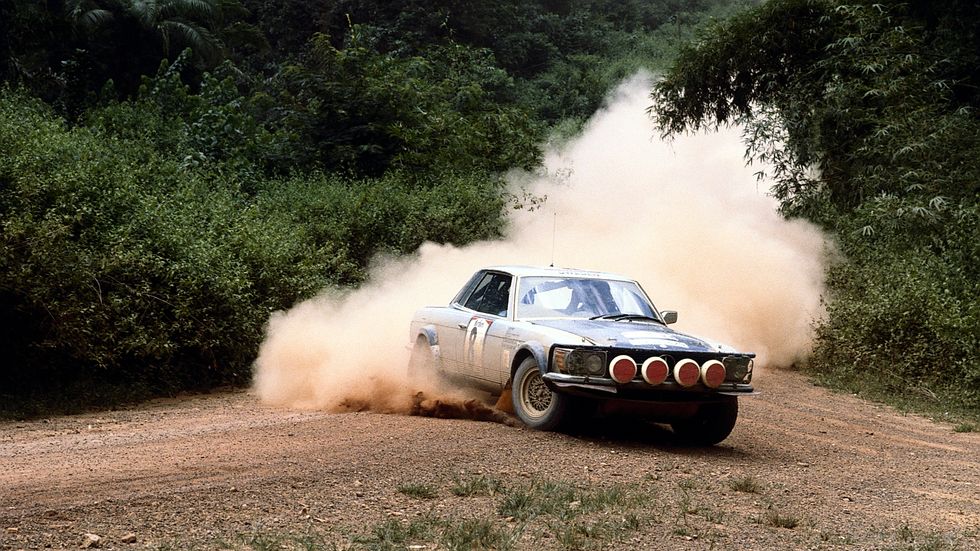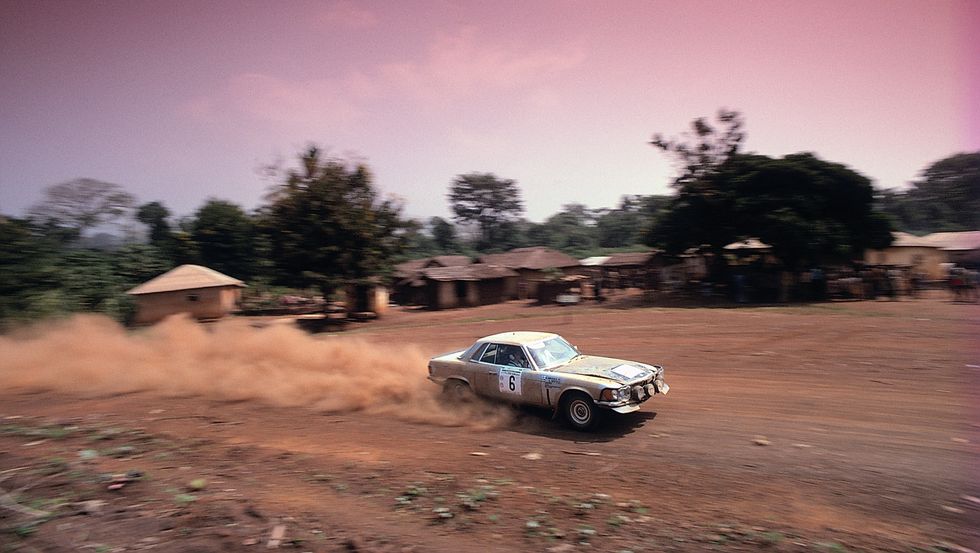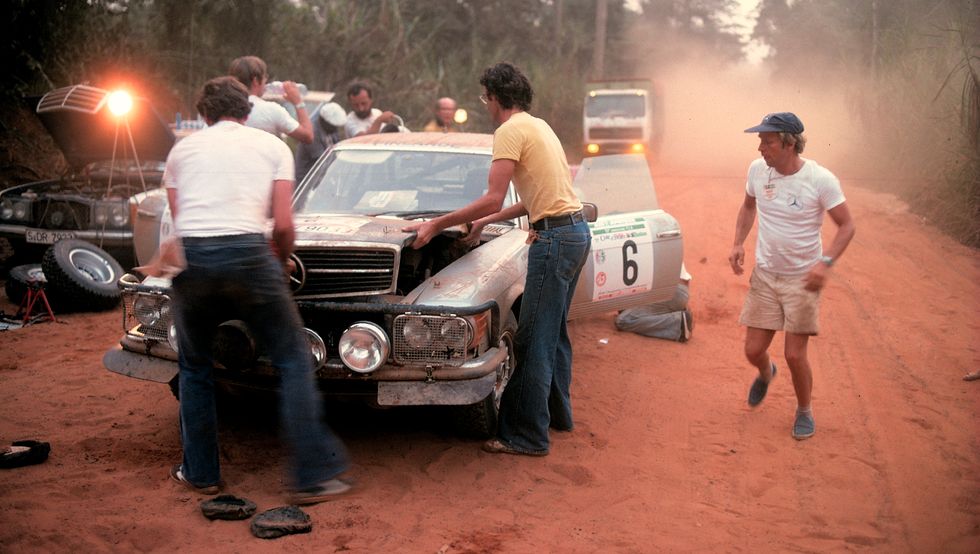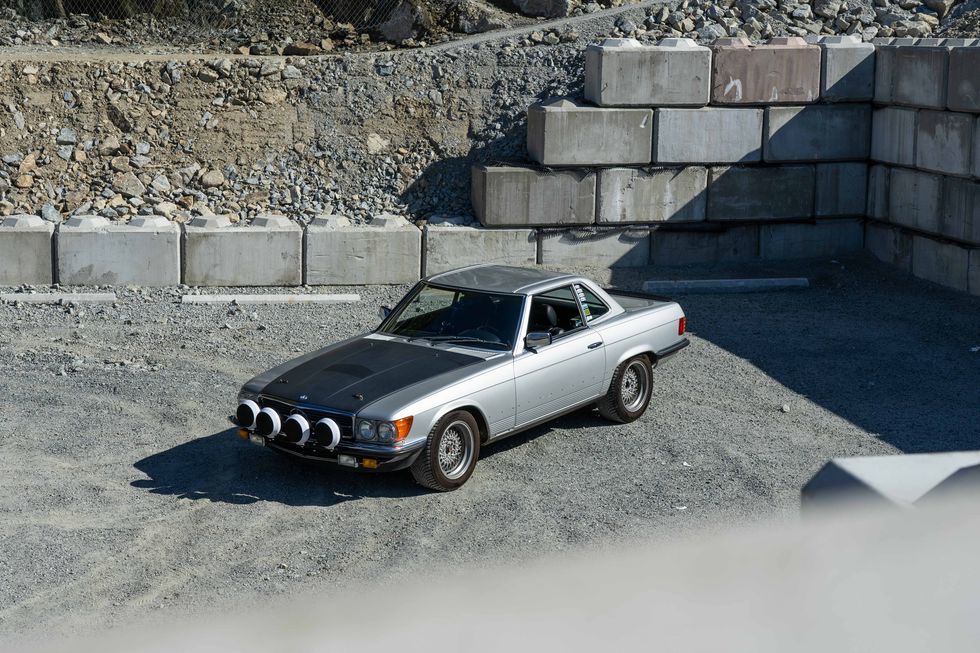On a dry and dusty forestry service road, a cluster of motorcyclists look up from unloading dirt bikes out of a pickup truck and freeze. Is that a Mercedes? You bet, and not some burly G-wagen, but a V-8 luxury coupe sporting a flat-black hood and a quartet of auxiliary rally lights. It thunders past, leaving a grey contrail and dropped jaws in its wake, a tribute to one of the most unlikely World Rally Championship (WRC) rally cars ever made.
Think WRC, and the images that pop into mind are Subarus pogoing over jumps and box-flared Audis spraying gravel. The driver of a Mercedes-Benz SL or SLC is a bit more likely to have a golf caddy than a Finnish-speaking co-driver. Or so you may have thought . . .

BRENDAN MCALEER|CAR AND DRIVER
A Boulevardier Goes Rallying
However, in 1977, Mercedes works team engineer Erich Waxenberger decided the hardtop-coupe version of the SL would make an ideal rally machine. The 107 was nearing 10 years old at the time and was a Mercedes grand tourer of the old school, with a long hood and an automatic transmission. A three-speed automatic.
Waxenberger was an unusual engineer. He was known for destroying so many Mercedes testing prototypes that an appeal was made to Mercedes boss Rudolf Uhlenhaut to ban him from driving. Uhlenhaut demurred.
What Waxenberger knew was that the 107—specifically the four-seater C107 coupe—was over-engineered, as were most of that era’s Mercedes models. What it lacked in agility to compete with the fizzy little Lancias and Datsuns could be made up for with brute force and precision German engineering. To satisfy the WRC’s rulebook, a homologation special was put into production: the V-8–powered 450SLC 5.0.
The 450SLC 5.0 received a 5.0-liter aluminum V-8 good for roughly 240 horsepower in street trim and more than 300 for racing. The hood and trunk were also aluminum, part of a weight-saving program that trimmed 125 pounds. Top speed was 140 mph.
Still, this was no sports car, but a luxury coupe with an automatic gearbox. The works racing cars even retained the power steering.

DAIMLER AG – MERCEDES-BENZ CLASSIC COMMUNICATIONS
Racing and Winning
Not only did the 450SLC 5.0 race, it won. For the 1978 running of the Vuelta à la América del Sud rally—running through 10 countries in South America, from Argentina to Chile—four 450SLCs were entered, and three of them finished: first, second, and fourth. A Mercedes-Benz 280E took third.

MERCEDES-BENZ AG – MERCEDES-BENZ CLASSIC COMMUNICATIONS
It’s impossible to overstate how long and grueling these pan-continental rallies were. The Vuelta à la América del Sud covered almost 18,000 miles of mud, gravel, and rutted track. With the bones of a fast German executive coupe underneath, the SLC was tough enough to survive the elements.
A clean sweep of the 1979 Ivory Coast Bandama Rally followed, though some of that result was down to the might of Mercedes-Benz as a company. Waxenberger deployed everything from endless spare parts to helicopters. The SLCs were reliable, but they also had all the help they needed.

DAIMLER AG – MERCEDES-BENZ CLASSIC COMMUNICATIONS
But on the tighter courses of the European rallies, the Mercedes juggernaut was just too big for its own good. At the Acropolis and Portugal rallies, little Italian cars scampered ahead while the Mercedes-Benzes ate up tires on the sharp corners. The brand’s top brass decided that anything other than crushing victory wouldn’t be good publicity, and the rallying ended.
Spotlighting a Little-Known Hero
Outside of Mercedes-Benz enthusiast circles, the 450SLC 5.0 remains something of a footnote, especially in North America. Sharp eyes will see that this example is not the rare SLC5.0, but a tribute to the factory rally machines built on an R107 platform. It’s a running work in progress, with auxiliary lights mounted but some bodywork and a full 5.0-liter V-8 ready to be swapped under the hood. And, just like the Mercedes that inspired it, this big cruiser was built to take on gravel.

BRENDAN MCALEER
For owner Yen-Hsien Liem, the idea to re-create one came from a local classic-car rally that includes extensive gravel sections. His daily, a modified 190E 2.3-16, is set up for tarmac, and abusing it seemed a shame. With underplating to shield the oil pan and overfenders fitted, the rally Benz will be able to shrug off anything even the roughest forestry roads will throw at it. As it is, it’s a shockingly competent gravel machine.